- Home
- Walt Whitman
Drum-Taps: The Complete 1865 Edition Page 9
Drum-Taps: The Complete 1865 Edition Read online
Page 9
The swarming ranks press on and on, the dense brigades press on;
Glittering dimly, toiling under the sun, the dust-cover’d men,
In columns rise and fall to the undulations of the ground,
With artillery interspers’d—the wheels rumble, the horses sweat,
As the army resistless advances.
Dirge for Two Veterans
1
The last sunbeam
Lightly falls from the finish’d Sabbath,
On the pavement here—and there beyond, it is looking,
Down a new-made double grave.*
2
Lo! the moon ascending!
Up from the east, the silvery round moon;
Beautiful over the house-tops, ghastly, phantom moon;
Immense and silent moon.
3
I see a sad procession,
And I hear the sound of coming full-key’d bugles;
All the channels of the city streets they’re flooding,
As with voices and with tears.
4
I hear the great drums pounding,
And the small drums steady whirring;
And every blow of the great convulsive drums,
Strikes me through and through.
5
For the son is brought with the father;
(In the foremost ranks of the fierce assault they fell;
Two veterans, son and father, dropt together,
And the double grave awaits them.)
6
Now nearer blow the bugles,
And the drums strike more convulsive;
And the day-light o’er the pavement quite has faded,
And the strong dead-march enwraps me.*
7
In the eastern sky up-buoying,
The sorrowful vast phantom moves illumin’d;
(’Tis some mother’s large, transparent face,
In heaven brighter growing.)
8
O strong dead-march, you please me!
O moon immense, with your silvery face you soothe me!
O my soldiers twain! O my veterans, passing to burial!
What I have I also give you.
9
The moon gives you light,
And the bugles and the drums give you music;
And my heart, O my soldiers, my veterans,
My heart gives you love.
How solemn, as one by one
How solemn, as one by one,
As the ranks returning, all worn and sweaty—as the men file by where I stand;
As the faces, the masks appear—as I glance at the faces, studying the masks;
(As I glance upward out of this page, studying you, dear friend, whoever you are;)
How solemn the thought of my whispering soul, to each in the ranks, and to you;
I see behind each mask, that wonder, a kindred soul:
O the bullet could never kill what you really are, dear friend,
Nor the bayonet stab what you really are:
...The soul! yourself I see, great as any, good as the best,
Waiting secure and content, which the bullet could never kill,
Nor the bayonet stab, O friend!
Lo! Victress on the Peaks!
Lo! Victress on the peaks!
Where thou standest, with mighty brow, regarding the world,
(The world, O Libertad, that vainly conspired against thee;)
Out of its countless, beleaguering toils, after thwarting them all;
Where thou, dominant, with the dazzling sun around thee,
Towerest now unharm’d, in immortal soundness and bloom—lo! in this hour supreme,
No poem proud I, chanting, bring to thee—nor mastery’s rapturous verse;
But a little book, containing night’s darkness, and blood-dripping wounds
And psalms of the dead.
Reconciliation
Word over all, beautiful as the sky!*
Beautiful that war, and all its deeds of carnage, must in time be utterly lost;*
That the hands of the sisters Death and Night, incessantly softly wash again, and ever again, this soil’d world:*
...For my enemy is dead—a man divine as myself is dead;
I look where he lies, white-faced and still, in the coffin—I draw near;
I bend down and touch lightly with my lips the white face in the coffin.*
To the leaven’d Soil they trod
To the leaven’d soil they trod, calling, I sing, for the last;*
(Not cities, nor man alone, nor war, nor the dead,
But forth from my tent emerging for good—loosing, untying the tent-ropes;)
In the freshness, the forenoon air, in the far-stretching circuits and vistas, again to peace restored,
To the fiery fields emanative, and the endless vistas beyond—to the south and the north;*
To the leaven’d soil of the general western world, to attest my songs,
(To the average earth, the wordless earth, witness of war and peace,)
To the Alleghanian hills, and the tireless Mississippi,*
To the rocks I, calling, sing, and all the trees in the woods,*
To the plain of the poems of heroes, to the prairie spreading wide,*
To the far-off sea, and the unseen winds, and the sane impalpable air;*
...And responding, they answer all, (but not in words.)
The average earth, the witness of war and peace, acknowledges mutely;
The prairie draws me close, as the father, to bosom broad, the son;*
The Northern ice and rain, that began me, nourish me to the end;
But the hot sun of the South is to ripen my songs.
FINIS
Notes
Many of the texts quoted in the notes are readily available online; URLs are specified for sources that might otherwise require lengthy searches. All biblical quotations are given in the King James translation. Textual information comes from Walt Whitman, Leaves of Grass and Other Writings, edited by Michael Moon, Sculley Bradley, and Harold W. Blodgett (New York: Norton, 2002), and/or Walt Whitman, Leaves of Grass: A Textual Variorum of the Printed Poems, edited by Sculley Bradley, Harold W. Blodgett, Arthur Golden, and William White, 3 vols. (New York: New York University Press, 1980). A few secondary sources are quoted or cited in the notes, including David Reynolds, Walt Whitman’s America: A Cultural Biography (New York: Vintage, 1996); James McPherson, Battle Cry of Freedom: The Civil War Era (New York: Oxford University Press, 1988); Drew Gilpin Faust, This Republic of Suffering: Death and the American Civil War (New York: Vintage, 2009); and Susan Dunn, Dominion of Memories: Jefferson, Madison, and the Decline of Virginia (New York: Basic Books, 2007).
INTRODUCTION
To William Douglas O’Connor, January 6, 1865; quoted in Walt Whitman, Leaves of Grass and Other Writings, edited by Michael Moon, Sculley Bradley, and Harold W. Blodgett (New York: Norton, 2002), 785.
Ibid., 279. Whitman also made small textual changes through the successive editions, documented in Walt Whitman, Leaves of Grass: A Textual Variorum of the Printed Poems: Volume II: Poems, 1860–1867, edited by Sculley Bradley, Harold W. Blodgett, Arthur Golden, and William White (New York: New York University Press, 1980).
See Ted Genoways, “The Disorder of Drum-Taps,” Walt Whitman Quarterly Review 24 (Fall 2006), 98–117.
See J. David Hacker, “A Census-Based Count of the Civil War Dead,” Civil War History 57 (2011), 306–47.
Whitman, Leaves of Grass, edited by Moon, 785.
The quoted phrases are from Walt Whitman, Specimen Days, section 101, available at http://www.bartleby.com/229/1101.html.
DRUM-TAPS
The 1871 Leaves cuts this eponymous title and replaces it with the first line. In 1871 and 1876, an epigraph previewed the large-scale turn from bellicosity to mourning found in all versions of Drum-Taps. Whitman subsequently transferred the lines of the epigraph to “The Dresser” (later “The Wound-Dresser�
��): “Aroused and angry, / I thought to beat the alarum, and urge relentless war, / But soon my fingers fail’d me, my face droop’d, and I resign’d myself / To sit by the wounded and soothe them, or silently watch the dead.”
Tympanum: the drum or drumhead, but also the inner ear or tympanic membrane. The “songs” of Drum-Taps are to strike the ear as the city struck the drums.
The city is not modern New York, the five boroughs of which were not incorporated until 1898, but the island of Manhattan.
Whitman loved Italian opera; this reference is not disparaging. The onset of national crisis compels the city to exchange “soft” feelings and other “costumes of peace” for martial fervor. Whitman had reason to link the start of the war with a rebuke to opera (see note 12).
Whitman was a month shy of forty-two when the war broke out, but he first moved from his native Long Island to Manhattan in 1841.
As a woman warrior, the personified Manhattan merges with the Greek goddess Nike (Victory) and with the volume’s recurrent figure of Liberty (Libertad); as the “Lady of ships” she is a ship’s figurehead come to life to lead her “million children” to war.
The Civil War began with the predawn bombardment of Fort Sumter in Charleston harbor, April 12, 1861; the fort fell to the Confederacy on April 14. News of the attack traveled the country by telegraph; Whitman learned of it around midnight on April 13 while returning home from a performance of Verdi’s Un ballo in maschera.
The stroke of Manhattan’s clenched fist on the pavement acts as the original drum-tap from which all others in the volume (and by extension the war) derive.
The beehive modeling harmonious community is a traditional image derived from Virgil’s Georgics (4:149–227). Whitman inverts the trope: The news from the South shocks the hive, whose inhabitants pour forth buzzing with martial fury.
Whitman’s account of Manhattan’s response to the outbreak of war is accurate but slightly misleading. Prior to Fort Sumter, New York City was “a nursery of pro-southern sentiment” (James McPherson, Battle Cry of Freedom: The Civil War Era [New York: Oxford University Press, 1988], 274); the response to the attack marked a startling turnaround registered in Whitman’s “shock electric.” On April 15, Lincoln called for a militia of 75,000 men to quell the rebellion. On April 20, in the city’s Union Square, 250,000 people gathered for what became known as the Great Sumter Rally, at the time the largest public gathering in the nation’s history.
Contemporary descriptions accord with Whitman’s: Within a week of Fort Sumter, regiments of departing troops were parading down Broadway to cheering crowds, where “thousands upon thousands lined the sidewalks”; see Third Annual Report of the Bureau of Military Statistics of the State of New York (Albany: The Bureau, 1866).
The Civil War established nursing as a female profession in America, as the Crimean War (1853–56) had done in England. Male Civil War nurses nonetheless outnumbered women by four to one.
Mannahatta was the Lenape Indian name for Manhattan, meaning “island of many hills,” first recorded when Henry Hudson “discovered” the island in 1609. Whitman wrote two poems entitled “Mannahatta,” one in 1860 and one (much shorter) in 1888; both invoke the city’s “aboriginal name” as a mark of grandeur. The shift here from Manhattan to Mannahatta elevates the effort to save the Union to a mythic-heroic “work for giants” in which artillery glitters like gold.
This seemingly incongruous cavil alludes to Whitman’s disillusionment with the extremism and demagoguery of the 1850s, a culture of corruption that he initially believed the war would purify; see David Reynolds, Walt Whitman’s America: A Cultural Biography (New York: Vintage, 1996), 413–21.
shut not your doors to me proud libraries
This poem was cut from Drum-Taps and moved, with significant revisions, to the prefatory “Inscriptions” section of Leaves of Grass, acquiring its final form in 1881. In Drum-Taps, “A book separate, not link’d with the rest,” explicitly written for soldiers and the love of comrades, it affirms the need for an independent Civil War volume. In “Inscriptions,” the “book separate” is no longer Drum-Taps but Leaves of Grass.
Libertad is Spanish for liberty, regularly used by Whitman as a feminine personification. “Arm’d Libertad” is another version of the warlike Mannahatta in the preceding poem.
cavalry crossing a ford
Whitman was familiar with the English painter William Hogarth (1697–1764), who in his Analysis of Beauty (1753) describes the serpentine shape as “the line of beauty” that excites the observer’s gaze. Hogarth associated the S curve with life and animation, and rectilinear lines with inanimate objects and death.
Guidon: swallow-tailed flags identifying each army unit’s unique colors and insignia.
song of the banner at day-break
Chord or cord: The image is that of a hawser, a thick rope consisting of three intertwined strands, used to moor a ship; the metaphor culminates in the segment’s penultimate line. The strands correspond to father, child, and banner/pennant.
Despite its title, this poem features two symbolic flags, not one: the rectilinear banner, presumably the Stars and Stripes, and the pennant “shaped like a sword.” Both fly from one of the forts in New York harbor.
Whitman’s roll calls of the states in Drum-Taps usually form a continent-spanning image of the Union in which geography is (manifest) destiny. That happens here with “CONTINENT” in capital letters, but this roll call is more specific: each state named played a key role in the long run-up to the war. Illinois hosted the debates between Stephen Douglas, defending slavery, and Abraham Lincoln, denouncing it as a “monstrous evil,” in their 1858 Senate race. Douglas won the election but Lincoln defeated him for the presidency in 1860. “Bleeding Kansas” was the scene of brutal guerrilla conflicts over the extension of slavery in the west, including the infamous Pottawatomie Massacre in which the radical abolitionist John Brown, with several of his sons, murdered five pro-slavery advocates. The turmoil followed the 1854 Kansas-Nebraska Act (sponsored by Douglas), which repealed the restriction on the westward extension of slavery imposed a generation earlier by the Missouri Compromise (1820). The Mississippi River belongs to the same symbolic network; it was both the major transport route for the South’s commerce in slaves and a major route for slaves fleeing north on the Underground Railroad toward freedom in Illinois and Ohio.
Little child: an ironic reference to the vision of universal peace in Isaiah 11:6: “The wolf shall dwell with the lamb, and the leopard shall lie down with the young goat...and a little child shall lead them.”
The rattlesnake was a symbol of the American colonies during the Revolutionary War era, partly on the basis of a mid-century cartoon by Benjamin Franklin representing the thirteen colonies as a dismembered snake over the motto “Join, or Die.” The pennant merges here with the famous naval flag of 1775 (the Gadsden flag) that had a coiled rattlesnake over the motto “Don’t Tread on Me.”
Valueless: invaluable.
by the bivouac’s fitful flame
The first of eight mentions of phantoms in Drum-Taps, including the Sequel (see note).
The phantasmal procession identifies this poem as a reverie in the sense used by nineteenth-century psychology (“mental science”): a train of involuntary images seen in a trance or waking dream.
1861
The personification of the “arm’d year” as a blue-clad soldier first seen in Manhattan balances the personification of Manhattan as an American Amazon in the opening poem. Manhattan forms the epicenter of the forces thus released; the soldier appears in different guises in different locales. Each of his avatars heads south and east, forming a grand pincer movement aimed at the heart of the Confederacy.
from paumanok starting i fly like a bird
Paumanok: the Indian name for Long Island, Whitman’s birthplace.
Canada was still part of the British Empire in 1861–65. Whitman expected it to become independent and join the Union in the near future. In
Democratic Vistas (1871) he predicted that “long before the second centennial arrives, there will be some forty to fifty great states, among them Canada and Cuba.”
the centenarian’s story
Now Fort Greene; scene of the 1776 Battle of Brooklyn; site of Civil War encampments as early as April 1861; and location of a large rally for the departure of the Thirteenth New York Regiment in answer to Lincoln’s call for a militia after Fort Sumter (see note 15).
Blind eyes: in Homer’s Odyssey (Book 8), a blind poet sings of the Trojan War while Odysseus listens. Tradition takes the passage as self-referential; Homer was reputedly blind. Whitman’s Centenarian thus becomes an American Homer, endowing the Revolution with the status of national myth. Homeric allusions recur throughout Drum-Taps.
Hooped guns: artillery pieces bound by hoops of metal around the gun barrel (but not invented until 1849).
Rais’d earth: breastworks, i.e., rocks or soil mounded breast high as fortification for defenders firing from a standing position.
George Washington, whose strategic retreat from Brooklyn Heights under cover of darkness prevented the Revolution from being crushed at the outset.
Maryland, though a slave state, remained in the Union; neighboring Virginia seceded on April 17, 1861, less than a week after Fort Sumter, making Richmond the Confederate capital. The young Revolutionary soldiers of the decimated brigade (most actually from Maryland) thus personify the national unity the North fought to restore.
Gowanus’ waters: In 1776 Gowanus Creek (called Gowanus Canal since 1869) connected to Gowanus Bay, which lies west of Brooklyn and south of Manhattan. The British occupied a farmhouse fronting the creek; after fierce fighting there, the Maryland troops retreated across the creek with heavy losses. Washington, observing the engagement from Cobble Hill, exclaimed: “Good God, what brave fellows I must this day lose!”
pioneers! o pioneers!

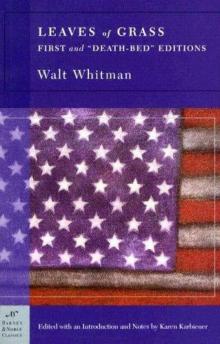 Leaves of Grass: First and Death-Bed Editions
Leaves of Grass: First and Death-Bed Editions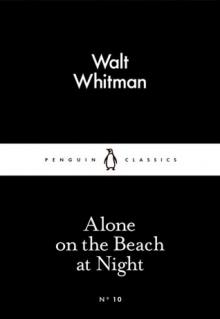 Alone on the Beach at Night
Alone on the Beach at Night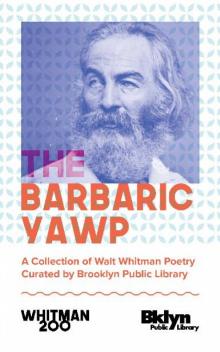 The Barbaric Yawp
The Barbaric Yawp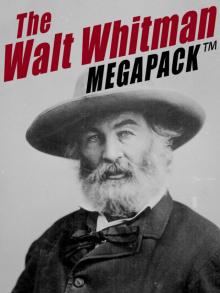 The Walt Whitman MEGAPACK
The Walt Whitman MEGAPACK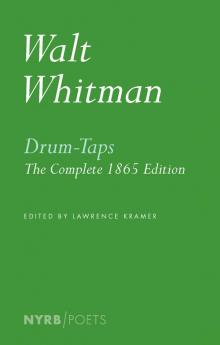 Drum-Taps: The Complete 1865 Edition
Drum-Taps: The Complete 1865 Edition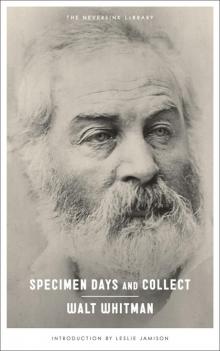 Specimen Days & Collect
Specimen Days & Collect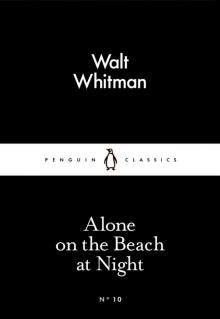 On the Beach at Night Alone
On the Beach at Night Alone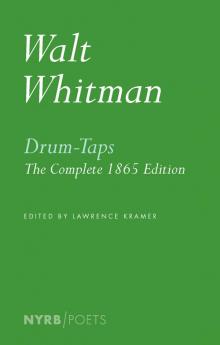 Drum-Taps
Drum-Taps